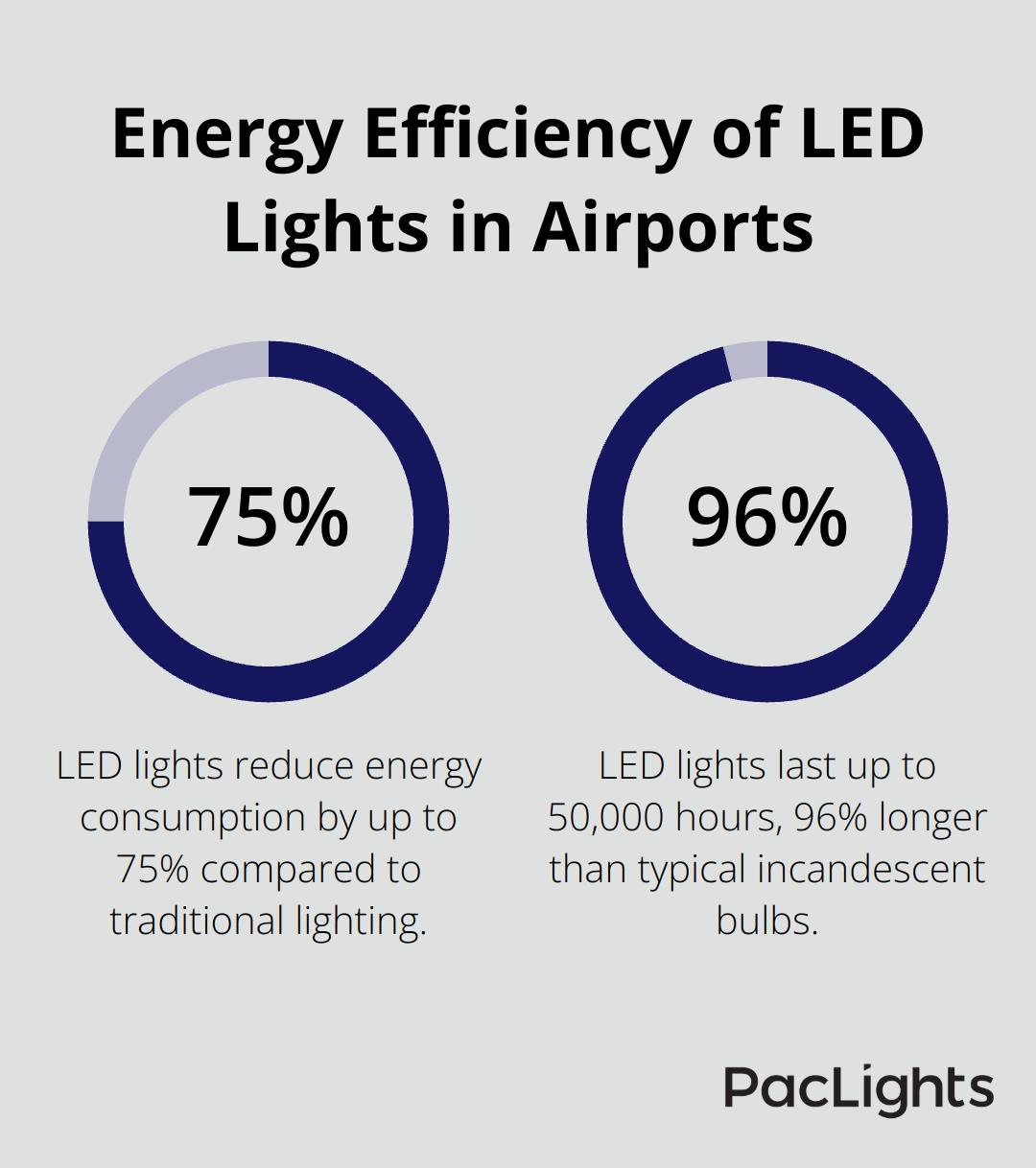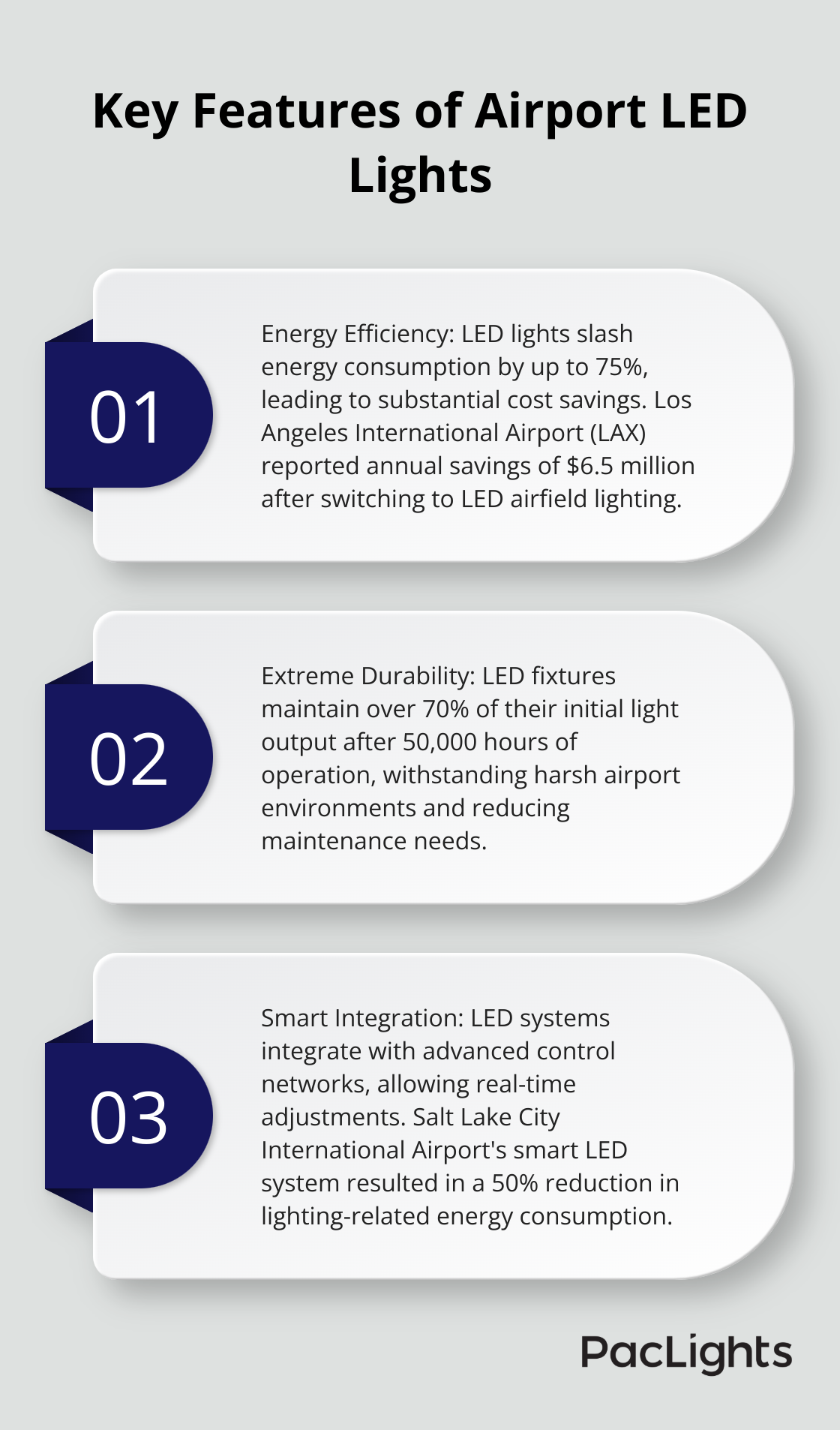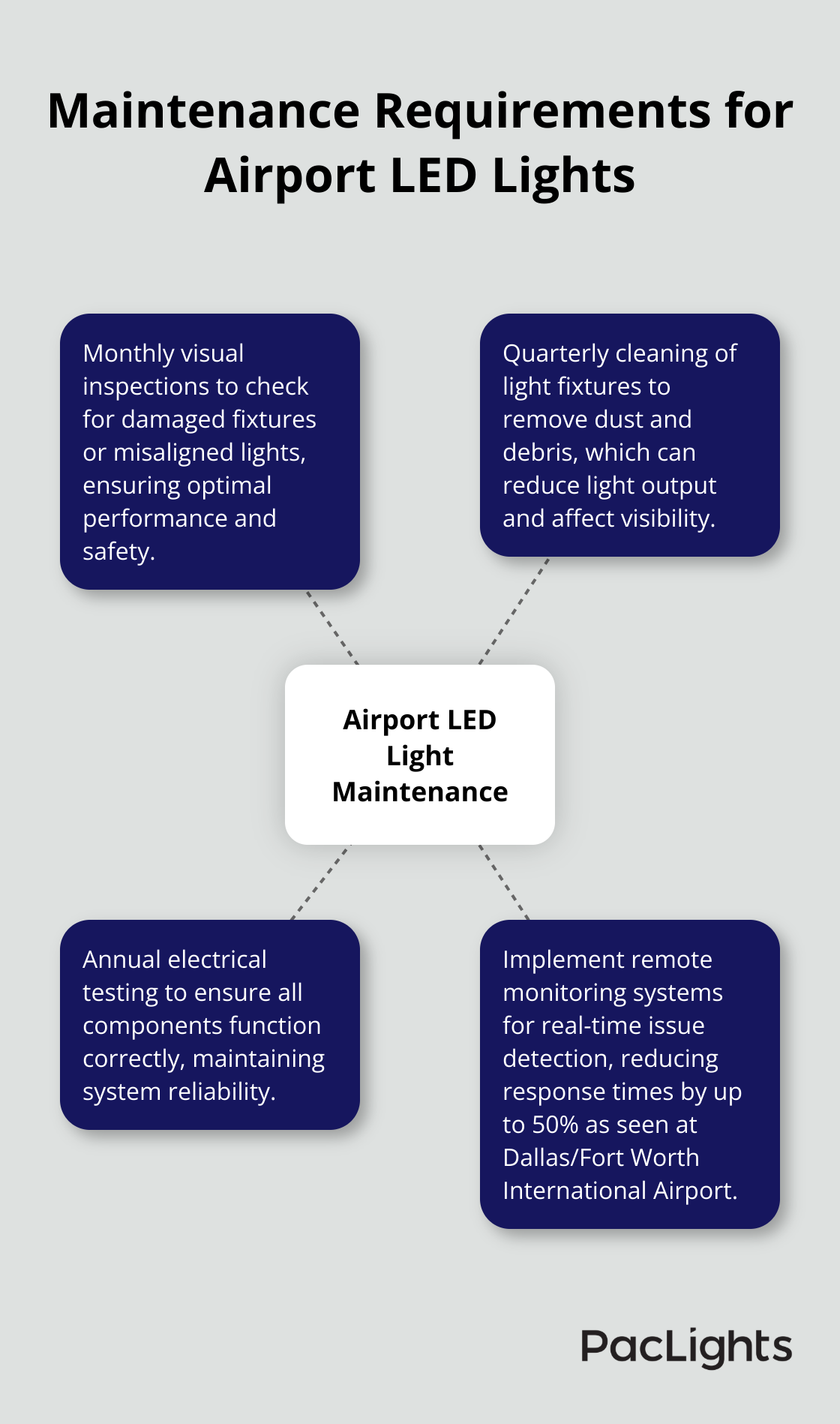Airport LED lights are revolutionizing aviation safety and efficiency. These advanced lighting systems guide aircraft during takeoff, landing, and taxiing operations, ensuring clear visibility in all weather conditions.
At PacLights, we understand the critical role these lights play in maintaining smooth airport operations. This comprehensive guide will explore the types, benefits, and implementation of airport LED lights, shedding light on their impact on modern aviation infrastructure.
What Are Airport LED Lights
Airport LED lights are advanced illumination systems that guide aircraft and enhance safety during critical operations. These lights utilize Light Emitting Diode (LED) technology to provide clear, bright, and energy-efficient lighting for runways, taxiways, and approach areas.
Runway Lighting
Runway lights form the backbone of airport lighting systems. They outline the edges and centerline of runways, which helps pilots identify landing zones and maintain proper alignment during takeoff and touchdown. The Federal Aviation Administration (FAA) specifies that runway edge lights should be white, while threshold lights (marking the start of the landing area) are green.
Taxiway Illumination
Taxiway lights guide aircraft between runways and terminal areas. These typically blue LED lights clearly mark the path for pilots during low-visibility conditions. Some airports also use green centerline lights on taxiways to provide additional guidance.
Approach Lighting Systems
Approach lighting systems (ALS) play a vital role in guiding aircraft during the final stages of landing. These systems use a series of light bars, often in a distinctive pattern, to help pilots align with the runway from several miles out. The Precision Approach Path Indicator (PAPI) system, which uses red and white lights to indicate the correct glide slope, is a common component of modern ALS.
Advantages of LED Technology
LED technology offers significant benefits over traditional incandescent lighting for airports:
- Energy Efficiency: LEDs consume up to 75% less energy, leading to substantial cost savings. A study by the Airport Cooperative Research Program found that medium-sized airports can save over $100,000 annually in energy costs by switching to LED lighting.
- Longevity: While incandescent bulbs typically last 1,000 to 2,000 hours, LED lights can operate for up to 50,000 hours. This extended lifespan dramatically reduces maintenance requirements and associated costs.
- Superior Visibility: LEDs produce bright, focused light that improves pilots’ ability to identify runway markings and obstacles, especially in poor weather conditions. This enhanced visibility directly contributes to safer airport operations.
- Integration with Control Systems: LED lights easily integrate with advanced control systems. This allows for dynamic adjustment of light intensity based on ambient conditions or specific operational needs, further optimizing energy use and enhancing safety.

As airports worldwide upgrade their lighting systems, LED technology becomes the standard for modern aviation infrastructure. Its combination of energy efficiency, longevity, and superior performance makes it an ideal choice for ensuring safe and efficient airport operations.
The next chapter will explore the key features of airport LED lights in more detail, including their durability in harsh environments and compatibility with advanced control systems.
What Makes Airport LED Lights Stand Out?
Unparalleled Energy Efficiency
Airport LED lights slash energy consumption by up to 75% compared to conventional lighting. This reduction translates to substantial cost savings for airports. Los Angeles International Airport (LAX) reported annual savings of $6.5 million after switching to LED airfield lighting. Smaller regional airports can expect proportional benefits, with energy bills often reduced by 50% or more.
Extreme Durability in Harsh Conditions
Airport environments test equipment to its limits. LED lights excel in these conditions, withstanding extreme temperatures, vibrations, and weather events. The U.S. Department of Energy reports that LED fixtures maintain over 70% of their initial light output after 50,000 hours of operation. This resilience results in fewer replacements and reduced maintenance downtime (crucial for busy airports where every minute of runway closure can cost thousands of dollars).
Superior Visibility for Safer Operations
LED lights provide exceptional illumination, critical for pilot and ground crew safety. Their instant-on capability and ability to maintain consistent brightness in cold temperatures make them ideal for airports in diverse climates. The FAA notes that LED runway lights can be seen from greater distances and through heavier fog than traditional incandescent lights, which significantly improves situational awareness for pilots during critical phases of flight.
Smart Integration with Control Systems
Modern airport LED lighting systems integrate seamlessly with advanced control networks. This integration allows for real-time adjustments based on traffic patterns, weather conditions, and time of day. Airports can program lights to dim during low-traffic periods, saving energy without compromising safety. Some systems even incorporate motion sensors that detect approaching aircraft, automatically increasing light intensity for landing and takeoff.
Salt Lake City International Airport implemented such a system, which resulted in a 50% reduction in lighting-related energy consumption while maintaining FAA compliance and enhancing operational flexibility.

The next chapter will explore the intricacies of installing and maintaining these advanced LED lighting systems in airport environments, ensuring their optimal performance and longevity.
How to Install and Maintain Airport LED Lights
Planning and Design
The implementation of an airport LED lighting system starts with thorough planning. A comprehensive site survey assesses existing infrastructure, identifies potential obstacles, and determines optimal light placement. Runway length, taxiway layout, and local weather patterns all influence the design process.
The FAA’s Advisory Circular on Airport Design specifies that runway edge lights must be placed no more than 10 feet from the runway edge. This precise positioning ensures maximum visibility for pilots during takeoff and landing. For taxiway lighting, the FAA recommends light spacing of no more than 200 feet, with shorter intervals on curves.
Installation Process
After design finalization, the installation process begins. This process involves trenching for power cables, installing light bases, and mounting LED fixtures. The use of corrosion-resistant materials and waterproof connections is essential to withstand harsh airport environments.
Proper alignment of lights is a key consideration during installation. Misaligned runway lights can confuse pilots and create potentially dangerous situations. The FAA mandates that runway centerline lights must be within 6 inches of the true centerline to maintain safety standards.
Maintenance Requirements
LED lights require less maintenance than traditional incandescent bulbs, but they still need regular attention to ensure optimal performance. A typical maintenance schedule for airport LED lights includes:
- Monthly visual inspections to check for damaged fixtures or misaligned lights
- Quarterly cleaning of light fixtures to remove dust and debris (which can reduce light output)
- Annual electrical testing to ensure all components function correctly
Seattle-Tacoma International Airport reported a 75% reduction in maintenance costs after switching to LED airfield lighting, demonstrating the long-term benefits of LED technology in airport applications.

Troubleshooting Common Issues
Airport LED lights occasionally experience issues despite their reliability. Common problems include flickering lights, dimming, or complete failure. These issues often stem from power supply problems, damaged cables, or faulty control systems.
Many airports implement remote monitoring systems to address these issues quickly. These systems can detect malfunctions in real-time, allowing maintenance teams to respond promptly. Dallas/Fort Worth International Airport uses a sophisticated monitoring system that has reduced response times for lighting issues by 50%.
When troubleshooting, it’s essential to follow proper safety protocols. Always de-energize circuits before performing maintenance, and use appropriate personal protective equipment (PPE) when working on airfield lighting systems.
Final Thoughts
Airport LED lights have revolutionized aviation safety and efficiency. These advanced systems provide superior visibility for pilots and ground crews, enhancing operational safety in all weather conditions. The energy efficiency of LED technology translates to significant cost savings for airports of all sizes, with some facilities reporting annual savings in the millions of dollars.
LED lights in airports demonstrate exceptional durability in harsh environments. Their long lifespan (often exceeding 50,000 hours) reduces maintenance requirements and downtime, ensuring continuous operation even in extreme conditions. This durability further contributes to reduced operational costs and environmental impact.
At PacLights, we offer cutting-edge LED lighting solutions for various applications, including airport environments. Our energy-efficient fixtures and advanced control systems are designed to meet the unique challenges of aviation lighting. We strive to help airports worldwide enhance their operations and reduce their environmental footprint.


Disclaimer: PacLights is not responsible for any actions taken based on the suggestions and information provided in this article, and readers should consult local building and electrical codes for proper guidance.